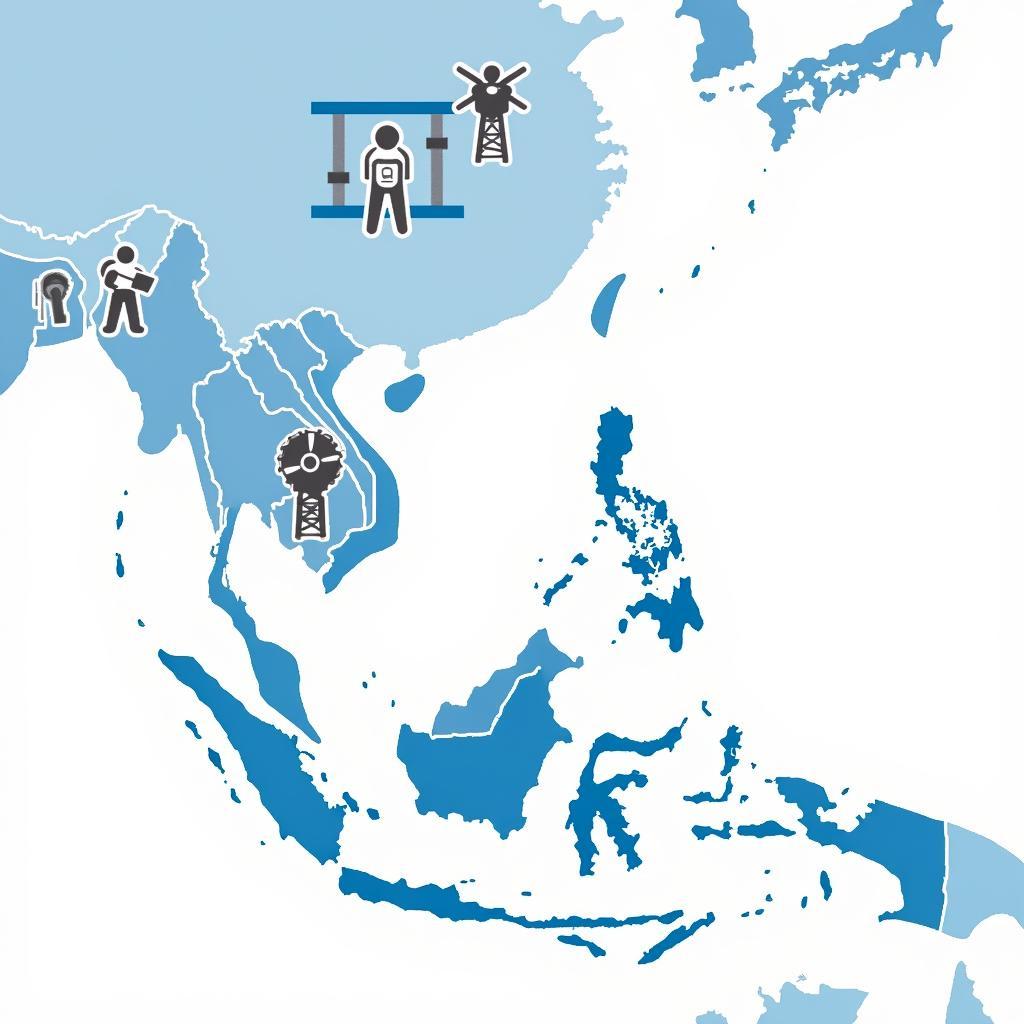Southeast Asia, a vibrant region brimming with cultural richness and economic dynamism, is home to the Association of Southeast Asian Nations (ASEAN countries). This diverse group of nations offers a captivating blend of ancient traditions, modern metropolises, and breathtaking natural landscapes. This article delves into the unique characteristics of each ASEAN country, highlighting their contributions to the region’s growth and exploring the opportunities and challenges they face.
Unveiling the Unique Charms of Each ASEAN Country
From the bustling streets of Bangkok to the serene rice paddies of Vietnam, each ASEAN country boasts its own distinct identity. Let’s embark on a journey to uncover the individual allure of these fascinating nations.
Brunei: The Abode of Peace
Brunei, a small but wealthy nation on the island of Borneo, is known for its opulent palaces and pristine rainforests. Its economy is heavily reliant on oil and gas, contributing significantly to the nation’s high standard of living.
Cambodia: The Kingdom of Wonder
Cambodia, with its rich history and magnificent temples like Angkor Wat, is a cultural treasure trove. The nation is steadily recovering from its turbulent past and embracing a future driven by tourism and agriculture.
Indonesia: The Emerald of the Equator
Indonesia, the world’s largest archipelago, is a melting pot of cultures and languages. From the volcanic peaks of Java to the coral reefs of Bali, Indonesia offers a diverse range of experiences for travelers and investors alike.
Laos: The Land of a Million Elephants
Laos, a landlocked country known for its laid-back atmosphere and stunning natural beauty, offers a tranquil escape from the hustle and bustle of modern life. The Mekong River, a lifeline for the country, flows through its heart, supporting agriculture and providing a vital transportation route.
Malaysia: Truly Asia
Malaysia, a vibrant mix of Malay, Chinese, and Indian cultures, is a melting pot of traditions and cuisines. From the Petronas Twin Towers in Kuala Lumpur to the pristine beaches of Langkawi, Malaysia offers a diverse range of experiences.
Myanmar: The Golden Land
Myanmar, a country emerging from decades of isolation, is slowly opening its doors to the world. Its rich cultural heritage, including the iconic Shwedagon Pagoda, is attracting increasing numbers of visitors.
The Philippines: The Pearl of the Orient Seas
The Philippines, an archipelago of over 7,000 islands, is known for its warm hospitality and stunning beaches. The country is also a major player in the BPO industry, contributing significantly to its economy.
Singapore: The Lion City
Singapore, a small island nation, is a global hub for finance, trade, and technology. Its impressive skyline, efficient infrastructure, and multicultural society make it a popular destination for business and leisure travelers.
Thailand: The Land of Smiles
Thailand, known for its vibrant street markets, ancient temples, and tropical beaches, is a popular tourist destination. The country’s economy is driven by tourism, agriculture, and manufacturing.
Vietnam: The Ascending Dragon
Vietnam, a rapidly developing nation, is becoming a major player in the global economy. From the bustling streets of Hanoi to the serene beaches of Nha Trang, Vietnam offers a diverse range of experiences.
ASEAN Countries: Facing the Future Together
The ASEAN countries face a number of challenges, including economic disparities, environmental issues, and political instability. However, through cooperation and collaboration, these nations are working together to address these challenges and build a brighter future for the region.
Dr. Anya Sharma, Southeast Asian Studies expert at the University of Singapore, notes, “ASEAN’s strength lies in its diversity. By leveraging their unique strengths and working together, these nations can overcome challenges and achieve shared prosperity.”
Mr. Lee Kuan Yew, former Prime Minister of Singapore, once said, “ASEAN is a work in progress. It is not a finished product. But it is a vital regional grouping that has brought peace and stability to Southeast Asia.”
Professor Maria Santos, economist specializing in ASEAN economies at the Ateneo de Manila University, adds, “The economic potential of ASEAN is immense. By fostering greater integration and promoting sustainable development, the region can achieve remarkable growth.”
Conclusion
The ASEAN countries represent a vibrant tapestry of cultures, landscapes, and economies. From the bustling cities to the tranquil countryside, each nation offers a unique and unforgettable experience. By working together, the ASEAN countries are building a stronger and more prosperous future for the region and its people. The future of ASEAN is bright, and its continued growth and development will undoubtedly shape the global landscape for years to come.
FAQ
- What does ASEAN stand for? (Association of Southeast Asian Nations)
- How many countries are in ASEAN? (10)
- What is the purpose of ASEAN? (To promote regional cooperation and integration)
- Which ASEAN country is the largest? (Indonesia)
- Which ASEAN country is the smallest? (Singapore)
- What are the official languages of ASEAN? (English)
- What is the ASEAN Economic Community (AEC)? (An initiative to create a single market and production base for ASEAN)
Other helpful resources:
- Exploring the culinary delights of ASEAN
- Investment opportunities in ASEAN countries
- The impact of climate change on ASEAN
Need further assistance? Contact us: Phone: 0369020373, Email: [email protected] or visit our office at Thon Ngoc Lien, Hiep Hoa, Bac Giang, Vietnam. Our customer service team is available 24/7.


